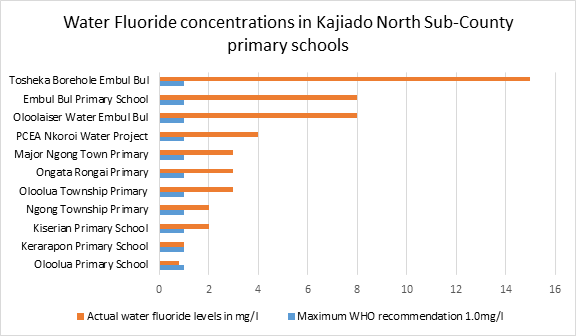Dental and skeletal fluorosis locks people out of jobs focused on appearance and physical strength like the police service, defence forces, media, public relations, sales and the airline industry
By Joyce Mutheu
Teenagers who consume water with high levels of fluoride have low emotional intelligence and poor academic ability, a study has shown.
Shocking results from the study describe long-drawn effects on adolescents such as poor concentration in class, poor performance in academics, and low self-esteem. The children also lack self-discipline and direction in life. They are confused, over cautious and lack ambition with boys being more vulnerable to these damaging effects than girls.
The study was conducted by Lincoln Imbugwa and Benjamin Induswe from Moi University, and Richard Okombo and Gladys Opinya from the University of Nairobi.
Titled: The Intellectual Efficiency of Adolescents Aged 13-15 Years Old Using Drinking Water with Varying Fluoride Concentrations in Kajiado North Sub-County, Kajiado County, the study sought the correlation between fluoride levels in drinking water to the intellectual development of children, particularly adolescents.
The research, conducted within six primary schools in Kajiado North sub-county, involved 269 pupils. Kenya’s Rift Valley, where Kajiado County sits, has one of the highest water fluoride concentrations recorded worldwide.

A focus paper by Geoscience Frontiers shows that more than 100 countries are affected globally by fluoride contamination in groundwater. The highest among these are countries from Africa (38), Asia (28), Europe (24), South America (5), North America (3), and Australia (2).
Fluoride comes from fluorine, a naturally occurring mineral produced from the erosion of underground rocks, for instance when the earth’s tectonic plates separate to form a rift valley. As this happens, fluorine seeps into the underground water reserves and combines with other minerals to become fluoride.
When the water is tapped for domestic use, it comes with the exact amount of fluoride as underground. Unfortunately, boiling the water does not kill fluoride, and while water filtration techniques may work, they do not remove all the fluoride in the water.
The normal concentration of fluoride in domestic water as recommended by the World Health Organization (WHO) is between 0.5 to 1.5 milligrams per litre (mg/l) of water. Consuming this minimal amount of fluoride is beneficial to humans as it prevents tooth decay by making teeth stronger and more resistant to acid attacks, especially in children, hence why many toothpaste brands have a standard amount of fluoride.
However, chronic and excessive consumption of larger quantities of fluoride causes dental and skeletal fluorosis. Dental fluorosis is a defect that causes yellow or brown discolouration on teeth. In severe cases, the teeth turn black and chip off or break. Skeletal fluorosis is a painful bone disease that leads to weak, brittle bones and makes a person more disposed to fractures, physical deformities and crippling.
But before fluoride creates physical malformations like dental and skeletal fluorosis, it seeps into the Central Nervous System (CNS), causing damage to soft tissues including the brain, liver, kidneys and spinal cord. In fact, fluoride penetrates the mother’s placenta during pregnancy and bypasses the blood-brain barrier, where it corrodes the brain cells of the growing foetus, disrupting its development. Excessive fluoride also damages the DNA structure, especially in the part of the brain that is responsible for memory and learning ability.
The high concentrations of fluoride in drinking water in Kenyan homes are an urgent cause of concern.
In Ngong municipality, where part of the study was done, some water sources recorded extremely high water-fluoride levels. For instance, Tosheka Borehole which supplies water to schools and residents in Embul Bul area, had a shocking fluoride concentration of 15mg/l, which is 10 times higher than the WHO recommendation of 1.5mg/l. Embul Bul Primary School and Oloolaiser Water & Sewerage Company had a shocking 8mg/l concentration of fluoride in domestic water.
According to the study, the higher the concentration of fluoride in the water being consumed by children, the lower their emotional intelligence and academic ability.
The children tested were between 13-15 years old, the age at which emotional intelligence helps teens build lasting social relationships, make good decisions and deal with difficult situations. The pupils were taken through a Wide Range Achievement Test (WRAT4), an academic skills assessment which measures reading skills, mathematics skills, spelling and comprehension.
Results of the tests were startling.
To begin with, more girls (178) than boys (91) volunteered to participate in the study. The researchers attributed this to shyness among the boys, and a general disinterest in participating in activities, which has been noted as one of the effects of high fluoride consumption.
| Fluoride concentration mg/l | Mean IE Score | Highest pupil mean IE score | Lowest pupil mean IE score | |
| Low Fluoride concentration | 0-1.0mg/l | 104.8 | 134 | 71 |
| Medium Fluoride concentration | 1.1-1.8mg/l | 106.33 | 130 | 76 |
| High Fluoride concentration | Over 1.8mg/l | 97.7 | 134 | 70 |
Test scores showed that children whose school water fluoride levels were lowest at 0-1.0 mg/l had the highest mean intelligence score of 104.8. Children whose schools had medium water fluoride levels at 1.1-1.8mg/l scored an average intelligence of 106.33. However, children whose school water had high fluoride levels of over 1.8mg/l got a mean intelligence score of 97.7. This is a stark difference of 7.1 and 8.63 points respectively.
Similar results showed that children whose household water fluoride levels were low at 0-1.0mg/l had a mean intelligence score of 107.4. Children whose household water had medium fluoride levels between 1.1-2.0mg/l had a mean intelligence score of 96.20. Those with high household water fluoride levels also had a mean intelligence score of 96.20. This is a difference of a staggering 11.2 points.
| Fluoride concentration mg/l | Mean IE Score | Highest pupil mean IE score | Lowest pupil mean IE score | |
| Low Fluoride concentration | 0-1.0mg/l | 107.4 | 134 | 71 |
| Medium Fluoride concentration | 1.1-2.0mg/l | 96.20 | 127 | 70 |
| High Fluoride concentration | Over 2.0mg/l | 96.20 | 128 | 72 |
The conclusion is that children in endemic fluoride areas are about five more times likely to develop low IQ and emotional intelligence in comparison to those who reside in areas without fluoride.
Children who score a high Intellectual Efficiency show positive traits such as independence and dominance. They are strong, self-reliant and have superior intellectual ability.
The opposite is true for children who show extremely low self-esteem. These traits have a long-lasting effect on children and teenagers such as excessive shyness, timid behaviour and lack of interest in social activities, going well into their adulthood.
Not only that, dental and skeletal fluorosis locks individuals out of jobs that focus on appearance and physical strength such as the police service, defence forces, media, public relations, sales and the airline industry, among others. Unemployment and the resultant lack of income lead to a cycle of drug and substance abuse, crime and a shorter life expectancy for these individuals.
It is a vicious cycle that must be broken at the source, experts say.
Currently, there is a policy gap in Kenya where county governments and private water providers are not required to purify domestic water. Households with high disposable income can afford to buy purified treated water, but this is not an option for the majority of households who live in rural areas and below the poverty line, yet they rely on underground water sources.
They recommend tapping domestic water from piped sources, although this is a challenge for many counties as rapid urbanization and population growth increase pressure on piped water sources. Another solution is defluoridation, whereby underground water is treated to reduce fluoride concentration to levels that are safe for human consumption.
Experts also recommend interventions for children growing up in high-fluoride areas, including learning and skills-based interventions. The United Nations Population Fund (UNFPA) states that Kenya has made strides in the empowerment of girls through programmatic interventions while ignoring the boy child. Similar targeted interventions could help boys improve.
There may be a need for vulnerable children in high-fluoride areas to be assessed and empowered to build up learning milestones and catch up with above-average children.
A good start is the Competency-Based Curriculum introduced in Kenya in 2017, which puts emphasis on creative skills-based learning rather than academic grading. If implemented optimally, children will have an opportunity to develop their creative knowledge, leading to better outcomes in adulthood.

















